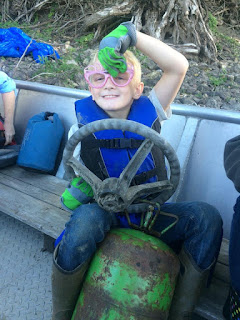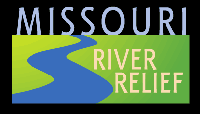2016 was a great year for trash (how often do you hear that one?)
So we have compiled a detailed list of all the materials we picked up over the year, both big and small.

But first, we would like to extend a tremendous thank you to everyone that has joined us for a clean-up, including volunteers, crew, and partner organizations. From St. Louis to Kansas City, 2016 was another remarkable year for Missouri River Relief, and we could not have done it without you!!
With that, please take some time to bask in the itemized glory of garbage that can no longer call the Big Muddy home.
For fun, we separated trash into general categories...

Clothing:
1 flimsy gray brassiere
1 leopard print G-string
5 flip-flop
1 pair pink plastic sparkle sunglasses (lenses gone)
1 sneaker
1 pair of wet shoes
1 hard hat
1 tie
1 hat
3 gloves

Furniture and house fixtures:
15 chair
1 couch
1 mattress
3 rusted bed springs
1 dresser drawer (wooden)
1 mirror
1 chaise lounge (aqua)
1 door

Appliances:
11 refrigerators
5 fridge door
7 refrigerator racks
1 refrigerator compressor with coils
4 TVs
2 chest freezer
1 garage door opener motor
1 oven grate
Toys and recreational items:
1 Frisbee
3 fishing pole
1 Snow Board
23 assorted balls (football, soccer, etc.)
1 toy chicken
1 toy sheep (contest winner)
1 red cardboard octopus (should have won the contest)
1 child’s 4-wheeler in pieces (steering wheel, axle, seat)
1 plastic toddler slide
3 plastic sleds
1 Tuggy the Tugboat
1 bicycle
1 blue plastic basketball hoop stand
1 piece of a swing set
1 Etch-a-Sketch
1 baby bottle
1 glow stick
1 Dinosaur toy
1 Mr. Potato Head
1 Space Panda
1 Anatomically Correct Baby Doll (It’s a Boy!)
1 Scooby Doo
1 Bowling Pin
1 bottle of blue glitter
1 green bottle of playdough
1 Big Wheels
In fact, we almost found enough trash to construct a Missouri River Relief vehicle!!
4 car seat
1 car under-tray (commonly known as “bellypan”)
1 trailer hitch
3 car bumper
5 car body pieces
1 gas can
2 plastic mud flap
1 gas tank cover
1 car headlight
1 crank shaft
1 truck bed liner
1 car engine cover
1 gas pipe (6’ long)
Here is a shortened list of the complete 2016 trash tally...
956 Bags Trash
126 Bags Recyclables
443 tires
34 55-gallon plastic barrels
11 refrigerators
49 large Styrofoam hunks
16 55-gallon metal barrel
39 5-gallon bucket
22 coolers
31 large tubs
19 propane tank (small)
15 chair
2 chest freezer
1 500-gal metal tank (rusted)
1 oil drain pan
4 truck tire w/out rim
3 metal cable
2 fuel tank drum
3 wooden pallets
3 car wheels (steel)
1 5-gallon plastic oil container
1 large rubber circular trough
1 boat bumper
4 car seat
7 camper parts (Designer Series camper)
1 car undertray (commonly known as “bellypan”)
1 trailer hitch
3 car bumper
5 car body pieces
4 large propane tanks
2 swimming pool parts
4.5 buoy
3 corrugated plastic pipe
1 boat seat
4 PVC pipe
1 yellow raft
2 country mailboxes (one with red flag up)
1 “Pittsburgh” US Geological Survey life vest
1 couch
3 rusted bed springs
3.5 full jugs of oil
1 oxygen tank
2 fence post
1 American Flag
1 section rusted iron gate
1 water jug
1 gas can
1 heavy aluminum pan
1 oven grate
1 sleeping bag (frog green)
3 fishing pole
2 television back
4 TVs
1 Christmas tree
1 valet sign
3 gloves
1 flimsy gray brassiere
1 Snow Board
1 sheet piling
1 leopard print g-string
3 metal drum
3 dirty diapers
2 plastic mud flap
1 door
1 gas tank cover
3 culvert
1 tent
1 cattle panel
12 hunks plastic
4 trash can lid
1 bed-liner
1 message in a bottle
1 car headlight
1 pump sprayer
2 garden hose
1 oil drain pan
1 gas tank cover
3 plastic milk crates
1 Freon tank
1 5-gallon stainless-steel milk can (very shiny)
1 2-cup glass measuring cup
3 paint cans
9 large pieces scrap metal
1 20-foot steel cable
1 metal spring
1 bunch fake grapes
1 12-foot iron pipe
1 6-foot roll acrylic sheeting (very heavy)
3 seed starter flats
1 radio vacuum tube
1 picnic table base (tubular steel)
2 rubber hose
1 garage door opener motor
6 wooden plank
1 bin dog feeder
4 duck decoy
1 Frisbee
1 sand bucket
5 flip-flop
1 jet ski tread
2 ball bat
23 assorted balls (football, soccer, etc.)
1 toy chicken
1 toy sheep (contest winner)
1 red cardboard octopus (should have won the contest)
1 child’s 4-wheeler in pieces (steering wheel, axle, seat)
1 plastic toddler slide
3 plastic sleds
1 Tuggy the Tugboat







































